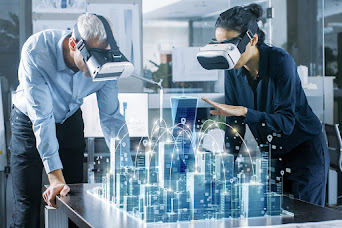Challenges, Applications, Social Aspects, and Future Trends of Virtual Reality Gaming
The arrival of VR gaming has revolutionized the world of games, allowing players to enjoy a whole new level of engagement that is far superior to normal monitor screens. In this paper, we look at the challenges of VR gaming by discussing its limitations, and social implications spacing it with some practical uses and dynamics that are worth looking for in the future.
Challenges
and Limitations
Motion
Sickness
An important barrier that is still
experienced by VR sickness remains motion. Fast movements within VR environment
may cause nausea and discomfort, because of sensory inconsistency.
Developers use such techniques as
smooth locomotion and teleportation to minimize the risk of motion sickness.
Still, the perfect balance between immersion and comfort is vital.
Hardware Requirements
i.
High Demands: To enable VR, there is a need
for high-performance hardware such as processors with solid GPU and enough RAM.
Fulfilling the needs is expensive.
ii.
Wireless Freedom: The development of wireless
VR technology is a promising trend that makes for increased mobility.
User-Friendly
Interfaces:
1. Intuitive
Controls
All interfaces of a VR have to be
user-friendly, especially taking into consideration the newcomers.
2. Hand
Tracking
The implementation of the most
advanced inventions, in this case, hand-tracking technology, can guarantee
virtual interactions without being forced to adapt.
Social
Aspects of Virtual Reality Gaming
A.
Virtual Communities:
•
Social relationships go beyond gaming in VR.
Individuals hold discussions in virtual hubs and chat rooms.
•
Personalized avatars improve social presence
and they bridge the divide between physical selves to digital selves.
B.
Multiplayer Experiences:
•
Many multiplayer VR games encourage
cooperative adventures.
•
Social VR Platforms: Events, concerts, and art
shows happen all the time on platforms such as Rec Room and VR Chat.
Applications
Beyond Entertainment
1.
Architectural Design:
§
Visualization: Before building, architects
leverage the power of VR technology in delivering design concepts and letting
clients have a virtual tour.
§
Remote Collaboration: Technicians work online,
editing projects simultaneously.
2.
Education and Training:
§
Experiential Learning: VR takes students to
battlefields and distant planets.
§
Medical Simulations: Surgeons perform
surgeries in VR, thereby minimizing the risks involved.
3.
Military and Healthcare:
§
Realistic Training: In VR soldiers train in non-physical
risk scenarios.
§
Therapeutic Potential: VR is supportive in
pain management and cases of anxiety.
Future
Trends and Innovations
1.
Haptic Feedback:
a)
Tactile Sensations: Haptic gloves and vests
improve immersion, as they bring the sense of touch into consideration.
b)
Full-Body Suits: The developers try to get
full-body haptic suits for a sensation in all the body parts.
2.
AI Integration:
a)
Dynamic NPCs: The AI-powered characters evolve
according to the behavior of players, impacting with more realistic
interaction.
b)
Procedural Content: AI creates living worlds
that can be explored endlessly.
3.
Beyond Recreation:
a)
Telepresence: VR can potentially revolutionize
remote working if it brings together employees around the world.
b)
Therapeutic Applications: The possible
application for VR therapy would be phobias and stress management.
The fact, therefore is that VR gaming
involves much more than just an escape; it’s a door to unparalleled creativity.
Undoubtedly, the technology will continue to shape and reshape VR, as it
impacts many spheres of our lives – from games to education. Don your
headphones, take a journey to the metaverse, and welcome progress.




Comments
Post a Comment